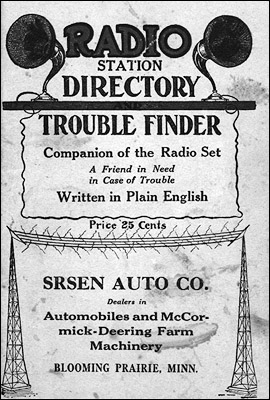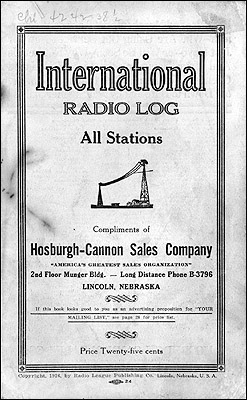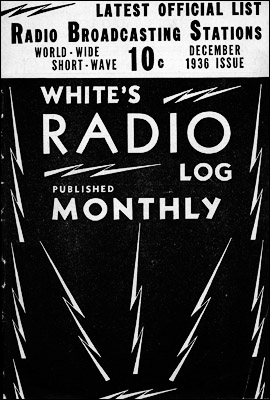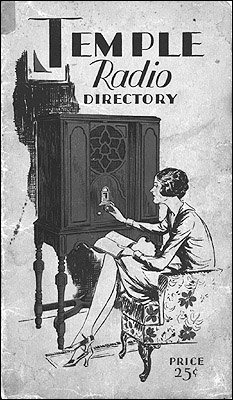Of Old Radios And Related Items--Published Monthly
Evolution of the American AM Band: A Brief History
BY Ed RIPLEY
WEB EDITIONThe following article seems appropriate for the last issue of the century, since it traces the history of AM-band radio, which has been so much a part of our radio listening pleasure for decades. As we look toward the inevitable development of digital radio, the subject of Ray Bintliff's supplementary article, we're happy to reflect on an aspect of radio's glorious 20th century. (Editor)
Ever wonder how the AM band got to be the way it is, and what it was like back in the early days? Today, in the United States, we have well over 4000 AM stations, operating on 116 frequencies, spaced 10 kHz apart. A good radio can separate, say 1260 from 1270, without any trouble. However, it wasn't always that way, and the early broadcast band went through much upheaval and change before arriving at what we're familiar with today.
One has to remember that radio broadcasting for entertainment evolved from a medium that was generally being used in a service capacity. The early "wireless" was largely being used for sending messages, mostly in code. Ship communication and wireless telegraphy were the order of the day on the spectrum we now know as the AM band.
Early Regulations
When the first pioneer broadcasting stations went on the air in the early 1920s, the Department of Commerce regulated the radio frequencies. So-called "entertainment" stations were allowed to operate on a frequency of 360 meters (roughly 833 kHz). A second frequency of 485 meters (approx. 690 kHz) was set aside for broadcasting crop reports and weather services. Neither the transmitting equipment nor the receivers were capable of operating in a narrow 10 kHz bandwidth, and the early entertainment stations all had to share the same space.
There was some variation within the band, as stations would sometimes shift their positions a bit when interference became excessive. This meant that listeners would sometimes have to search for their favorite station, and with primitive receiving equipment it could be a challenge. Local stations would take turns or share time on the same frequency. Interference from distant stations was less of a problem in the earliest days because the crystal sets and other primitive receivers weren't all that sensitive. As more sophisticated receiving sets came into wide use, however, the problem of nighttime "skywave" became readily apparent.
The cover of a 1925 radio station directory.
Expanding the Broadcast BandWhat had started out in 1920-1921 as a handful of stations -- notably KDKA, Pittsburgh; WJZ, Newark; WWJ, Detroit; and a few others -- very quickly became a crowd. A second frequency was added by Commerce Secretary Herbert Hoover in 1922, allowing stations to use 400 meters (approximately 750 kHz). 360 meters was dubbed "Class A" and the new band was known as "Class B," the latter having been envisioned as a band for "better quality" stations. Certain technical requirements had to be met for Class B transmission, and a maximum power of 1000 watts was authorized. Class A stations, in those days, varied in power from as little as 5 watts to as many as 500.
According to Thomas H. White, in his Internet article "Building the Broadcast Band," the number of stations authorized to operate on 360 meters reached 524 by March, 1923. Once again, the Commerce Department acted to expand the broadcast band, this time assigning all of the space from 550 to 1350 kHz for AM broadcasting. Frequencies were spaced 10 kHz apart, and stations would still be divided into Class A, with a maximum of 500 watts, and Class B with a top operating power of 1000 watts.
Under this plan, none of the stations operating on 360 meters would be forced to change, and could stay on the frequency as "Class C" stations, if they wished. It was hoped that most would voluntarily switch to one of the less congested frequencies.
The band expansion helped relieve the congestion, of course, but with more than 600 stations on the air by the mid-1920s and with the vastly improved receiving equipment, the situation was hardly any better, especially at night. In 1927 the Federal Radio Commission (FRC) was formed to be a "traffic cop" for the burgeoning radio broadcasting industry. The standard broadcast band was expanded again, this time from 550 to 1500 kHz.
Sharing Frequencies and Pairing Stations
The FRC had the monumental task of sorting through the "tower of babble," reassigning frequencies and pairing stations to share band space. Many of the early stations were not happy with their new assignments, and in some of the largest cities as many as five stations would share a frequency. In fact, the last of the shared time operations were recently eliminated when three Chicago stations on 1240 kHz were finally combined into one. Those stations -- WCRW, WEDC and WSBC -- had shared space on the same channel since the 1920s.
The cover of the 1926 "International Radio Log."
Another method of controlling the interference on the AM band was the assigning of "daytime only" radio stations. These stations were allowed to operate only during the sunrise to sunset hours, which of course varied throughout the year. The obvious reason for this type of restriction was the band itself. The so-called "skywave" activity, produced by the ionispheric layer present in the upper atmosphere, causes signals to be deflected back to Earth at night, increasing the amount of potential coverage (not to mention interference) by hundreds or even thousands of miles.A few of the daytime stations are quite old, and have been operating on that basis since the 1920s. WEW in St. Louis on 770 kHz is just such an example. In recent years, the rules have been relaxed somewhat, and some former daytimers have been able to expand to pre-sunrise hours, meaning that they can get some kind of signal on the air by at least 6:00 a.m. Similarly, post-sunset operation offers daytime stations extended evening operation, and for many of them it means they can operate round-the-clock with reduced power.
Band Division
In the 1930s, further refinements were made to AM broadcasting. The Federal Radio Commission became the Federal Communications Commission (FCC), with more authority and greater international cooperation, primarily with Canada and Mexico. By then, the band had become divided into three major frequency categories, Clear Channel, Regional and Local. The "clears" were further subdivided into 1A and 1B groups.
A 1A clear could operate at full power, day and night up to 50,000 watts, and was usually the only station on a given frequency, except, perhaps, for a few low-power daytime stations which may have been licensed to operate in a distant part of the country. Familiar examples of 1A clears are WFAN (formerly WNBC), New York; WLS, Chicago; KFI, Los Angeles; WHO Des Moines; and WCCO Minneapolis-St. Paul.
An article such as this would be remiss if it didn't mention WLW, the 1A clear channel station in Cincinnati, operated by pioneer receiver manufacturer Powel Crosley. Much has been written about WLW (See A.R.C. November 1992), so we will not elaborate too much about it here, except to say it was America's one great experiment with super power on AM.
WLW was given special temporary authority to operate on its clear channel of 700 kHz with a power of 500,000 watts, an incredible feat for its time. In the mid-1930s this powerhouse was easily heard throughout North America and much of the world by night. Even by day, it was calculated that its ground wave signal reached eastward to Virginia, south to Georgia, west to Iowa, and north well into Canada. Crosley billed it as "The Nation's Station," and kept it running on super power until 1939, when the FCC finally decided that the experiment was over and WLW returned to 50,000 watts.
Probably the most famous and most enduring of the published radio station directories was "White's Radio Log." Pictured here is an issue from the mid-1930s.
The station simply caused too much interference to stations on adjacent frequencies, especially 690 kHz, a Canadian clear channel then occupied by CFRB, Toronto. A friend of mine who grew up in Hannibal, Missouri, in the 1930s claimed that one rainy night, he heard WLW coming through the gutters and downspouts of his home, without benefit of a radio, such was the intensity of its signal. In the 1960s, there was a revival of interest in super-power broadcasting, but in the end the FCC rejected the idea. By then, the need for such high-powered stations was virtually nonexistant.1B clear channel stations could also have up to 50,000 watts, but shared the frequency with a similar station in another part of the U. S. Two present-day examples of 1B sharing are WTOP in Washington, DC, and KSTP in St. Paul, Minnesota, both operating on the same frequency with maximum power, but directionalized at night so their signals do not adversely interfere with one another. Another example is WSAI (once WCKY) in Cincinnati and station KFBK in Sacramento which co-operate as 50,000 watters on 1530 kHz.
Regional or Class III stations were licensed to coexist on given frequencies, but with maximum power of 1000 watts, and later raised to 5000 watts. An example of a regional channel is 570 kHz where such stalwarts as WMCA, New York; WSYR, Syracuse; WNAX, Yankton, SD; KLAC, Los Angeles; and KVI, Seattle, operate, along with about two dozen other stations. Another example is 1250 kHz where WTAE, Pittsburgh; WDAE, Tampa-St. Petersburg; WEMP, Milwaukee; KTMS, Santa Barbara, California; and WDVA in Danville, Virginia, broadcast along with 60 other stations.
Directional Antenna Stations
What made the coexistence of so many stations possible was the directional antenna system, which, in turn, was made possible by the development of the "vertical radiator" tower in the early 1930s. AM radio waves travel both by ground and by air. These new antenna systems were more effective for transmitting ground wave signals, which was an advantage in the daytime, but cut down on the "skywave" interference at night. They also made possible the directional antenna array, allowing signals to be "phased" and sent in certain directions, rather than a circular pattern.
If you have ever seen an AM station that had a multiple number of towers in a row or in a box pattern, you were witnessing a directional antenna. Prior to the 1930s, stations used a horizontal or "flat top" antenna similar to the one pictured on the cover of the 1925 Radio Station Directory (photo, p. 4).
Stations began to utilize directional arrays in the late 1930s. WFLA in Tampa, Florida, was one of the first, if not the very first commercial AM station in the United States to utilize a vertical directional antenna. It was a 3-tower system on the shore of Tampa Bay. In more recent years the station moved the array to a new site several miles away with additional towers and tower height.
Local Broadcast Frequencies
Still another class of broadcast frequency is the "local." Six frequencies on the AM band were assigned by the FCC for this service. They were originally 1200, 1210, 1310, 1370, 1420 and 1500. Maximum operating power was 100 watts, day and night. Primarily, stations on these channels were designed to service their local city of license, and many of them were in smaller towns. However, more than a few big city stations were "locals" which posed a big restriction, even back then. Today, two examples of local channel stations in large cities are KYPA (formerly KGFJ), Los Angeles and WALR, Atlanta. The latter has operated under a variety of call letters over the years including WATL, WAKE, and WIGO.
Maximum power for the "locals" was later raised to 250 watts. In the late 1950s, another raise gave these stations 1000 watts by day. Finally, in the 1980s, the FCC allowed the Class IV locals to operate at a maximum 1000 watts day and night. In most instances these stations were, and still are, nondirectional.
Today, there are approximately 165 stations operating on each of the six local channels, making the interference level very intense. Even with 1000 watts, these stations, for the most part, are only effective to about 25 or 30 miles by day and as little as 10 to 15 miles at night. The six local channels today are 1230, 1240,1340, 1400, 1450 and 1490.
FREQUENCY SHIFTS -- 1940--1980s
Many of the stations listed in old radio logs were operating on different frequencies from where they broadcast today. In part, this is because of the big frequency shift of 1941. As a result of treaty agreements with the U. S., Canada, Mexico, and parts of the Caribbean, further realignment took place just before World War II. Lower band stations (540-750 kHz) largely stayed put, but mid- and upper-band stations shifted frequencies. For instance, clear-channel WCCO in Minneapolis-St. Paul went from 810 to its present 830 kHz. Similarly, WLS in Chicago went from 870 to 890, and so on.
Many of the upper band AM stations made a 30 kHz shift. A typical example is WDCW, (the former WFBL) in Syracuse, New York, a station I remember from my own childhood. It shifted from 1360 to 1390 kHz, where it remains today. Also, during this same period, the AM band was expanded to 1600 kHz, allowing for 10 new clear channel and regional frequencies.
During the 1960s, broadcasters began to argue for expanded use of the 1A clear channels. They reasoned that there was no longer a necessity for a station to serve most of the United States. With the proliferation of both AM and FM stations, virtually every part of the country could listen to stations broadcasting from their own local areas. Over the next two decades the rules would be relaxed, and by the early 1980s the clear channel frequencies were being shared both day and night by other broadcasters.
The original 1A clear channel stations would remain as 50,000 watt nondirectional operations, but stations in distant parts of the country could now operate directionally on the 1A clear frequencies. WCTS in Maplewood, Minnesota, is a typical example. It operates on 1030 kHz, with 50,000 watts by day and 1000 watts at night, protecting the original occupant of the channel, WBZ in Boston, after dark.
In the 1970s and 1980s the AM band went through some tough times. FM had languished for more than a generation, due in part to the public's fascination with television. Also, the personal and legal struggles between RCA head, General David Sarnoff, and FM inventer, Edwin Armstrong, have to be listed as part of the reason for FM remaining on the sidelines.
Sarnoff pushed ahead with RCA's development of television in the late 1930s and 1940s at the very same time that Armstrong was trying to bring FM into commercial viability. In the 1960s FM finally began to come into its own with its inherent lack of static and interference and the easy ability to broadcast in stereo. The once dominant AM band eventually found itself with only about 25 percent of the audience.
AM in the Present
However, there is renewed interest today in AM radio. The FCC has recently expanded the band to 1700 kHz. If you have a late model car, you may already have discovered this extra bit of spectrum space on your car radio. A number of disadvantaged stations -- daytimers, stations with extremely limited signals or very high interference levels -- have been given the option of applying for one of the new upper-band channels. Each will operate with a daytime power of 10,000 watts, reducing to 1000 watts at night, nondirectional.
A station in Elizabeth, New Jersey, was the first to go on the new space and can be heard nights on 1660 kHz over much of eastern North America. I have personally heard the station in Florida and Minnesota. Other stations have recently begun operating on the new AM space, and more are forthcoming. Many antique radios can pick up this expanded band. Back in the 1930s the so-called "police band" included the 1600-1700 kHz space, and a lot of the old AM dials were able to tune up to 1700 or even 1800 kHz.
Another improvement for some AM stations is the FCC rule which no longer limits regional stations to 5000 watts. Some of the oldtimers, such as WTMJ, 620 kHz, in Milwaukee, have been able to increase to 50,000 watts by day. Others such as KFWB in Los Angeles and WFLA, Tampa-St. Petersburg, also have applied for higher wattage and may already be operating with it by the time you read this. The old power parameters no longer apply. In the past, a regional station in the U. S. had to be 500, 1000, 2500 or 5000 watts. Now, power increases will be governed by how much will fit and still keep the station within legal interference tolerances. A station might have 6600 watts by day and 4350 by night, or whatever.
The cover of the "Temple Radio Directory" of the late 1920s.
Then, there is AM stereo. It hasn't caught on with the public to any appreciable extent, and relatively few receivers are equipped to receive it. However, a number of AM stations broadcast in stereo, and it may become a factor in the future.So, with the expanded frequencies and the general revitalization going on, AM is alive and well. While the days of AM dominance are long gone, the prognosis for the future looks good. There should be plenty to listen to on the AM band for a long time to come.
References:
Downs, Bertram. Radio Station Directory & Trouble Finder. St. Paul, Minn.: Bertram W. Downs Co., 1925.
International Radio Log. Lincoln, Nebraska: Radio League Publishing Co., 1926.
Lewis, Tom. Empire of the Air. New York, N. Y.: Harper Perennial, 1991
The M Street Radio Directory, M Street Corp., 1995
Schecter, Dorothy. "WLW, 'The Nation's Station." Antique Radio Classified, November 1992.
Temple Radio Directory. Chicago, Ill.: Temple Corp., 1929.
The MIT list of Radio Stations on the Internet. Massachusetts Institute of Technology, June, 1998.
White's Radio Log. Bronxville, N. Y.: C. DeWitt White Co., December, 1936.
White Thomas H. "Building The Broadcast Bank," Internet, Jan. 1, 1998.
Whitney, Philip. "Radio Broadcasting in 1925." Antique Radio Classified, November 1992.
Special thanks to Steven T. Moravec, President of the Phoenix Media Group, for providing valuable assistance in preparing this article.
(Ed Ripley, 2276 Holloway Ave., Maplewood, MN 55109)Ed Ripley and his wife Irene have been avid antique radio enthusiasts for more than 16 years. A commercial radio broadcaster for 30 years, Ed 's career in radio also included management positions. He has programmed radio stations in Tampa-St. Petersburg and Jacksonville, Florida, as well as in Cleveland, Ohio; Rochester, Minnesota; and Minneapoli-St. Paul, Minnesota.
| [Free Sample] [Books, etc., For Sale] [Subscribe to A.R.C./Renew] [Classified Ads] [Auction Prices] [Event Calendar] [Links] [Home] [Issue Archives] [Book Reviews] [Subscription Information] [A.R.C. FAQ] URL = http://www.antiqueradio.com/Evol_AM_Ripley_12-99.html Copyright © 1996-9 by John V. Terrey - For personal use only. Last revised: November 26, 1999. For Customer Assistance please contact ARC@antiqueradio.com or call (978) 371-0512 Pages designed/maintained by Wayward Fluffy Publications
Antique Radio Classified |



